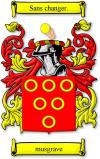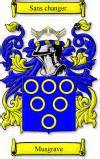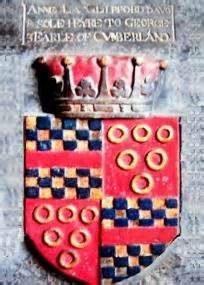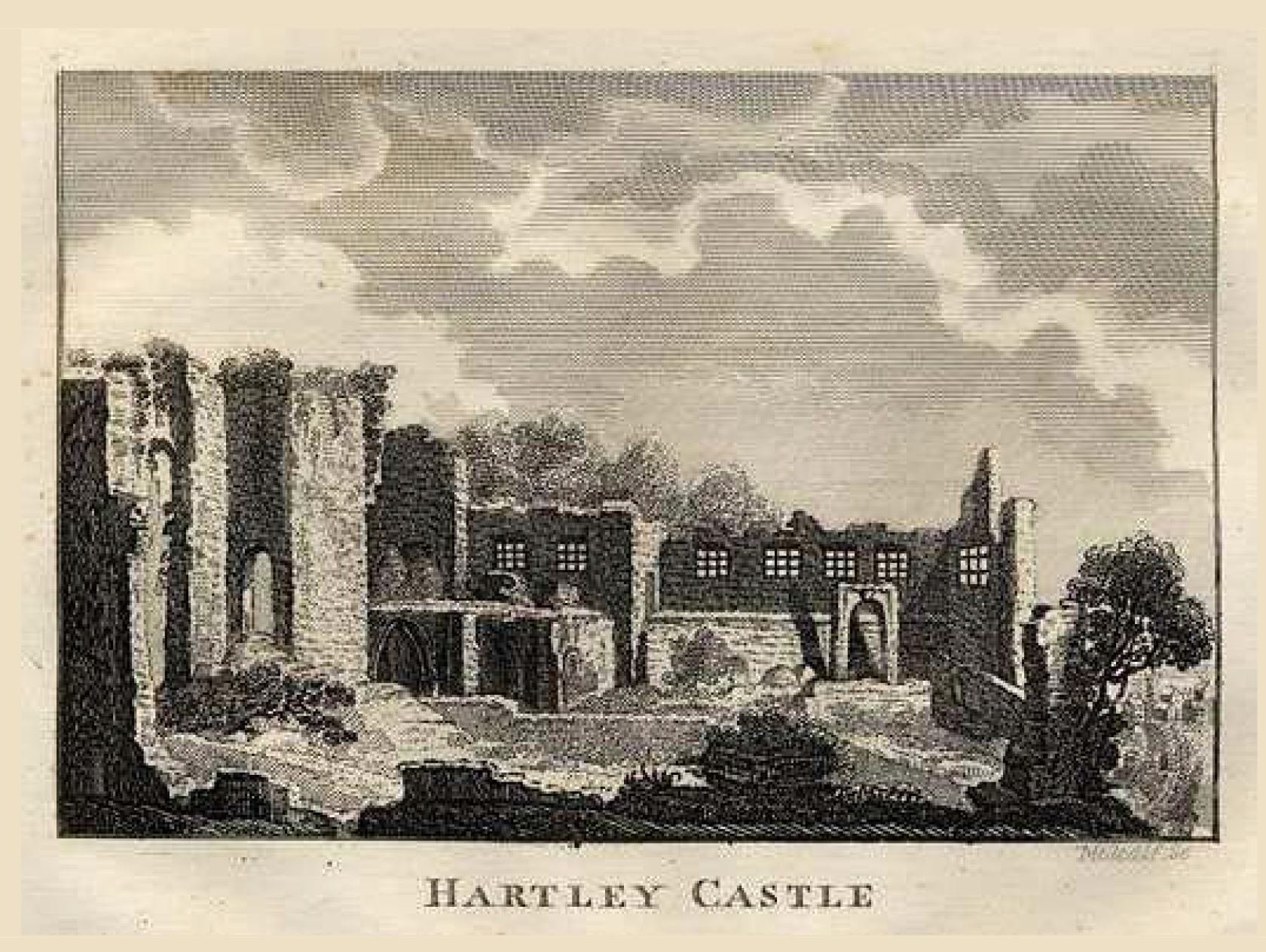
Coat of Arms



So Where Did The Name Musgrove Originate?

Ancestors and Aristocrats
The ancient family name of Mucegros, originally from the region of Ecouen, France, is now represented in England in its modern form of Musgrave, as a locational name in various parishes in the north of England. A locational name usually denotes where a man held land and where he actually lived. The original bearer would take his name from the village, town or the area in which he settled and the chosen name would then identify his whole family, and follow them wherever they moved. For the Musgrave family name this is aptly described in William Camden's Brittania of 1586:
Where the River Eden runs by, the villages of Great and Little Musgrave may seem to derive their name from the warlike family of Musgrave ...
The name originates from the old Norman surname de Mucegros and its pedigree can be traced from Lord Gamel de Mucegros born around 1030. His descendants are linked through his son, Wascelinus, living in the time of William the Conqueror and King Henry I, to his grandson Stephen de Mucegros who was born in 1095 in the village of Great Musgrave in a northern region of the country referred to at the time as the Earldom of Carlisle. This region was part of Scotland until 1157, when Henry II of England resumed possession of the area from Malcolm IV of Scotland, and formed two new counties, Westmorland and Carliol (Cumberland), from the former Earldom. Accordingly, the first members of the Musgrave family to actually live and become established in England were Stephen de Musgrave's lineal descendants over the next two centuries or so.
Thomas de Musgrave (1302-1372) of Great Musgrave was returned to Parliament for the county of Westmorland and was one of the commanders in the vanguard of the army in the battle of Neville's Cross, which took place to the west of Durham and was the decisive battle against the Scottish invasion of northern England in October 1346. The battle ended with a crushing defeat of the Scots and the capture of their king, David II of Scotland. Thomas de Musgrave was rewarded with a knighthood and a handsome annuity with which he purchased Hartley (Harcla) Castle in Kirkby Stephen from Ralph de Neville. In October 1353, a royal licence was granted to crenellate (fortify) the castle because it was "situated near the Scottish Marches and because our enemy the Scots have often burned and destroyed it".
Sir Thomas had married Margaret De Ros in 1335,and Hartley became the family home where their son, also Sir Thomas de Musgrave, (1337-1409), Lord of Musgrave, and his wife Elizabeth Fitzwilliam (1337-1382) lived. Sir Thomas de Musgrave was active in public office and was elected as Member of Parliament for the county of York in 1363 and 1369, Sheriff of Cumberland in 1393 and Member of Parliament for Westmorland in 1399. Sir Thomas and Elizabeth had two sons, Thomas who died in infancy and Richard. When Sir Thomas died, Hartley Castle and the Lordship of Musgrave devolved upon his surviving son and heir, Sir Richard Musgrave (1355-1409), who married Elizabeth Wollaston and had one son, Sir Thomas de Musgrave (1378-1447).
In the Musgrave chapel on the south side of the castle grounds is a plain altar tomb dedicated to Sir Richard Musgrave, Elizabeth Wollaston his wife and Thomas his son, with the Musgrave Coat of Arms on the edge of the slab. In this chapel there is another and earlier altar tomb assigned to Sir Richard's great grandfather, also Sir Richard (1226-1301). When this tomb was removed, on the rebuilding of the chancel, skeletons were found in a walled grave underneath the tomb; and in the grave was also found a boar's tusk, confirming the local tradition that this knight killed the last wild boar on Wild Boar Fell.
 The Hartley estate continued to grow and dominate the area, particularly through marriage and land acquisition. Sir Thomas de Musgrave married Joan D'Acre in 1397 and their son, Sir Richard de Musgrave (1398-1464), married Elizabeth Beetham, and inherited the Beetham estate near Carnforth on the death of Edward Beetham, Elizabeth's only surviving brother. The most notable acquisition, though, came about in 1430 from the marriage, at the age of just 13 years, of Sir Richard and Elizabeth Beetham's first-born son, Sir Thomas de Musgrave (1417-1457) to Joan Stapleton (1414-1478), the eldest daughter of Lord William Stapleton of Edenhall. Sir Thomas and Joan Stapleton had four daughters: Margaret, Eleanor, Isabel and Mary and four sons: Richard, John, Nicholas and William, all living with their parents at Edenhall. Lord Stapleton died in 1458, a year after the death of William Hilton, the husband of Mary, his younger daughter. Sir Thomas Musgrave also died at this time and this left Joan's eldest son, Sir Richard Musgrave (1431-1491) as the male heir to the Edenhall estate, which came into the Musgrave family when she died in 1478.
With the acquisition of Edenhall, the Musgraves became one of the most important families in the north of England, with lands and estates spread across most of Cumberland and Westmoreland and extending into Yorkshire. This also marked a significant development in the expansion of the family, with Sir Richard Musgrave and his three brothers John, Nicholas and William becoming the progenitors of the four main branches of the Musgrave tree, namely: the principal branch of Sir Richard Musgrave of Hartley Castle and Edenhall in Westmorland, Sir John Musgrave of Musgrave Hall (Fairbank) in Penrith, Sir Nicholas Musgrave of Hayton Castle in Cumberland and Sir William Musgrave of Crookdale, in Cumberland.
The Hartley estate continued to grow and dominate the area, particularly through marriage and land acquisition. Sir Thomas de Musgrave married Joan D'Acre in 1397 and their son, Sir Richard de Musgrave (1398-1464), married Elizabeth Beetham, and inherited the Beetham estate near Carnforth on the death of Edward Beetham, Elizabeth's only surviving brother. The most notable acquisition, though, came about in 1430 from the marriage, at the age of just 13 years, of Sir Richard and Elizabeth Beetham's first-born son, Sir Thomas de Musgrave (1417-1457) to Joan Stapleton (1414-1478), the eldest daughter of Lord William Stapleton of Edenhall. Sir Thomas and Joan Stapleton had four daughters: Margaret, Eleanor, Isabel and Mary and four sons: Richard, John, Nicholas and William, all living with their parents at Edenhall. Lord Stapleton died in 1458, a year after the death of William Hilton, the husband of Mary, his younger daughter. Sir Thomas Musgrave also died at this time and this left Joan's eldest son, Sir Richard Musgrave (1431-1491) as the male heir to the Edenhall estate, which came into the Musgrave family when she died in 1478.
With the acquisition of Edenhall, the Musgraves became one of the most important families in the north of England, with lands and estates spread across most of Cumberland and Westmoreland and extending into Yorkshire. This also marked a significant development in the expansion of the family, with Sir Richard Musgrave and his three brothers John, Nicholas and William becoming the progenitors of the four main branches of the Musgrave tree, namely: the principal branch of Sir Richard Musgrave of Hartley Castle and Edenhall in Westmorland, Sir John Musgrave of Musgrave Hall (Fairbank) in Penrith, Sir Nicholas Musgrave of Hayton Castle in Cumberland and Sir William Musgrave of Crookdale, in Cumberland.